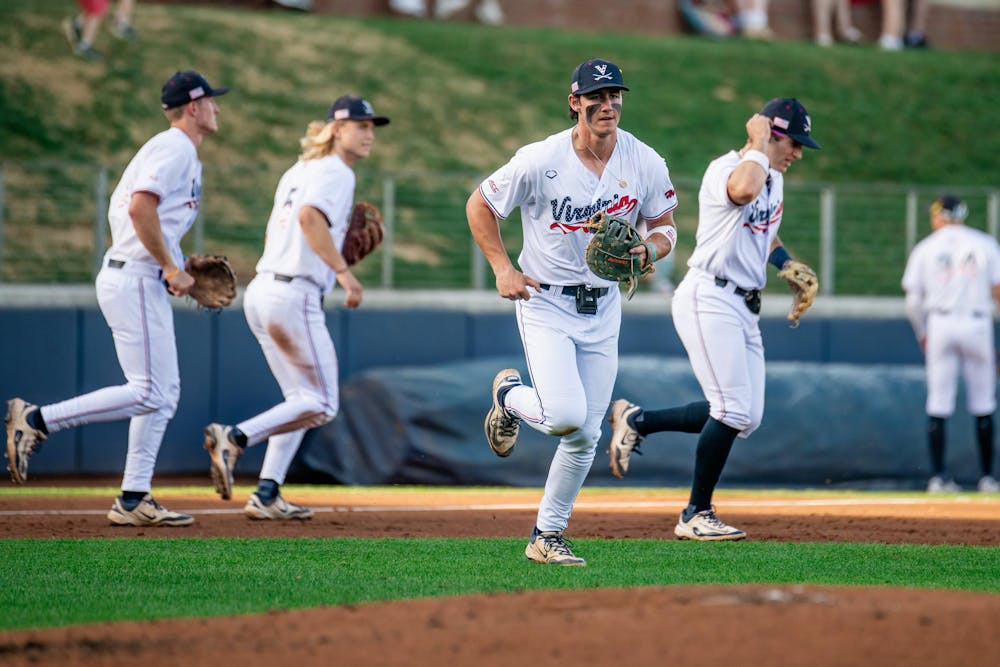Graduate student Tyler Gorecki and senior Petey von Ahn arrive at Disharoon Park roughly an hour before the first pitch of any given home game. After checking in and grabbing their credentials, they head to the press box before logging in to a local URL that gives them access to Trackman data collected from cameras positioned across the ballpark.
Gorecki and von Ahn serve as co-directors of the Virginia baseball data team. Now in their third and fourth years with the team, and second as co-directors, both understand the growing importance of analytics in shaping modern baseball strategy.
Formerly overlooked, statistics — like on-base percentage, walk rate and on-base plus slugging — emerged as key tools for player evaluation and development in the early 2000s, shifting the focus away from traditional metrics and reshaping the way the game is understood. These metrics were part of a larger movement known as sabermetrics — an analytical approach to understanding baseball through objective data rather than tradition or intuition.
Virginia, one of the nation’s premier collegiate baseball programs over the past decade, has embraced this shift under Coach Brian O’Connor. The program’s data team was founded during the 2021-22 season, and the installation of Trackman cameras and software before the 2023 season marked a major step forward in its ability to collect and analyze in-game data.
Invented in 2003, Trackman was a small Danish golf startup before beginning to apply its Doppler radar technology to baseball in 2008. Fast forward 17 years, and Trackman has become the backbone of baseball analytics programs across the world. Since then, continued investments in tracking and camera technology have allowed the Cavaliers to steadily expand this part of their game.
Ahead of the 2025 season, Virginia installed new Automated Rule-Based Workload Evaluation (ARWE) cameras at Disharoon Park, replacing six initial Synergy cameras. Each camera records game footage and uses software to tag specific plays and track in-game data — a major but necessary investment.
Each pitch is tracked via the Trackman and ARWE cameras for its horizontal and vertical break, spin rate and velocity. The cameras also capture a pitcher’s release point — both in terms of height off the ground and distance from the center of the mound. From there, the data team identifies pitch type and outcome — whether it was a strike, a ball or put in play for a hit or an out.
Trackman processes the camera feedback and generates data for every individual action on the field, from pitch characteristics to batted ball outcomes. That data is then uploaded to the local URL that Gorecki and von Ahn monitor.
After each game, von Ahn produces pitching and umpire reports using the Trackman data that is collected. He then uses a coding software that runs the data and produces a report in a digestible manner outside of a giant data sheet.
Those reports are sent to Travis Reifsnider, the program’s Director of Player Development and Scouting, who identifies trends that could be a point of emphasis for O’Connor and his staff.
With Trackman and the addition of ARWE cameras, which record and track every pitch and play regardless of which team is on the field, each report also includes information on opposing pitchers. The reports provide valuable insight particularly for ACC opponents and high-leverage series where the Cavaliers could possibly face the same relief pitcher multiple times in the same series or at a later point in the season.
Some of the most critical data reports for Virginia, however, are the umpire reports. These provide insight into specific umpire tendencies and how Cavalier pitchers can attack hitters in the most efficient way.
“I use called balls and strikes to develop a standard strike zone and then pull any missed calls because, like any umpire, college umpires are not perfect but they generally have tendencies,” von Ahn said.
Still, while the numbers offer valuable insights, there is more to baseball than just the data.
“Baseball is the best sport to acquire data in discrete events where you can measure so many things at once, but it's also such a mental sport that you need to find a balance,” Gorecki said. “We’re not here to force data on the team. Our job is to provide it where it's useful as a tool.”
That tool can be traced back to “Moneyball” — the 2003 book and its 2011 film adaptation — which showcased how the Oakland Athletics challenged the assumption that a high player payroll was necessary for success. Instead, they proved that with the right data, even a small-market team could compete.
Ben Wieland, a quantitative analyst for the Philadelphia Phillies, said that the growing emphasis on analytics is increasingly important.
“It’s no secret in Major League Baseball that everyone has a data analytics department,” Wieland said. “I think it’s a cool role where you can see what you do on a spreadsheet and computer actually put into practice on the field.”
“Moneyball” came out 20 years ago, and now teams are leveraging data more than ever — using it to make roster decisions, guide arbitration cases, negotiate free agency contracts and make decisions on the field.
But the Virginia data team is not trying to change the game — just sharpen it.







